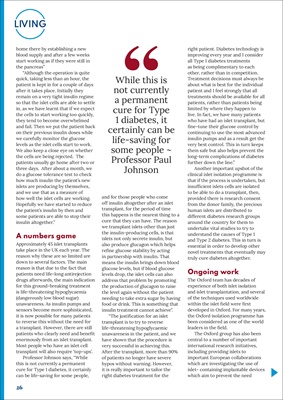
26
LIVING
home there by establishing a new
blood supply and after a few weeks
start working as if they were still in
the pancreas"
"Although the operation is quite
quick, taking less than an hour, the
patient is kept in for a couple of days
after it takes place. Initially they
remain on a very tight insulin regime
so that the islet cells are able to settle
in, as we have learnt that if we expect
the cells to start working too quickly,
they tend to become overwhelmed
and fail. Then we put the patient back
on their previous insulin doses while
we carefully monitor the glucose
levels as the islet cells start to work.
We also keep a close eye on whether
the cells are being rejected. The
patients usually go home after two or
three days. After about a month, we
do a glucose tolerance test to check
how much insulin the patient's new
islets are producing by themselves,
and we use that as a measure of
how well the islet cells are working.
Hopefully we have started to reduce
the patient's insulin by then and
some patients are able to stop their
insulin altogether."
A numbers game
Approximately 45 islet transplants
take place in the UK each year. The
reason why these are so limited are
down to several factors. The main
reason is that due to the fact that
patients need life-long antirejection
drugs afterwards, the main indication
for this ground-breaking treatment
is life-threatening hypoglycaemia
(dangerously low blood sugar)
unawareness. As insulin pumps and
sensors become more sophisticated,
it is now possible for many patients
to reverse this without the need for
a transplant. However, there are still
patients who clearly need and benefit
enormously from an islet transplant.
Most people who have an islet cell
transplant will also require 'top-ups'.
Professor Johnson says, "While
this is not currently a permanent
cure for Type 1 diabetes, it certainly
can be life-saving for some people,
and for those people who come
off insulin altogether after an islet
transplant, for the period of time
this happens is the nearest thing to a
cure that they can have. The reason
we transplant islets other than just
the insulin-producing cells, is that
islets not only secrete insulin, but
also produce glucagon which helps
refine glucose stability by acting
in partnership with insulin. That
means the insulin brings down blood
glucose levels, but if blood glucose
levels drop, the islet cells can also
address that problem by promoting
the production of glucagon to raise
the level again without the patient
needing to take extra sugar by having
food or drink. This is something that
insulin treatment cannot achieve".
"The justification for an islet
transplant is to try to reverse
life-threatening hypoglycaemic
unawareness in the patient, and we
have shown that the procedure is
very successful in achieving this.
After the transplant, more than 90%
of patients no longer have severe
hypos without warning. However,
it is really important to tailor the
right diabetes treatment for the
right patient. Diabetes technology is
improving every year and I consider
all Type 1 diabetes treatments
as being complimentary to each
other, rather than in competition.
Treatment decisions must always be
about what is best for the individual
patient and I feel strongly that all
treatments should be available for all
patients, rather than patients being
limited by where they happen to
live. In fact, we have many patients
who have had an islet transplant, but
fine-tune their glucose control by
continuing to use the most advanced
insulin pumps and as a result get the
very best control. This in turn keeps
them safe but also helps prevent the
long-term complications of diabetes
further down the line."
Another important upshot of the
clinical islet isolation programme is
that if the process is undertaken, but
insufficient islets cells are isolated
to be able to do a transplant, then,
provided there is research consent
from the donor family, the precious
human islets are distributed to
different diabetes research groups
around the country for them to
undertake vital studies to try to
understand the causes of Type 1
and Type 2 diabetes. This in turn is
essential in order to develop other
novel treatments that eventually may
truly cure diabetes altogether.
Ongoing work
The Oxford team has decades of
experience of both islet isolation
and islet transplantation, and several
of the techniques used worldwide
within the islet field were first
developed in Oxford. For many years,
the Oxford isolation programme has
been considered as one of the world
leaders in the field.
The Oxford group has also been
central to a number of important
international research initiatives,
including providing islets to
important European collaborations
which are investigating the use of
islet- containing implantable devices
which aim to prevent the need
While this is
not currently
a permanent
cure for Type
1 diabetes, it
certainly can be
life-saving for
some people ~
Professor Paul
Johnson